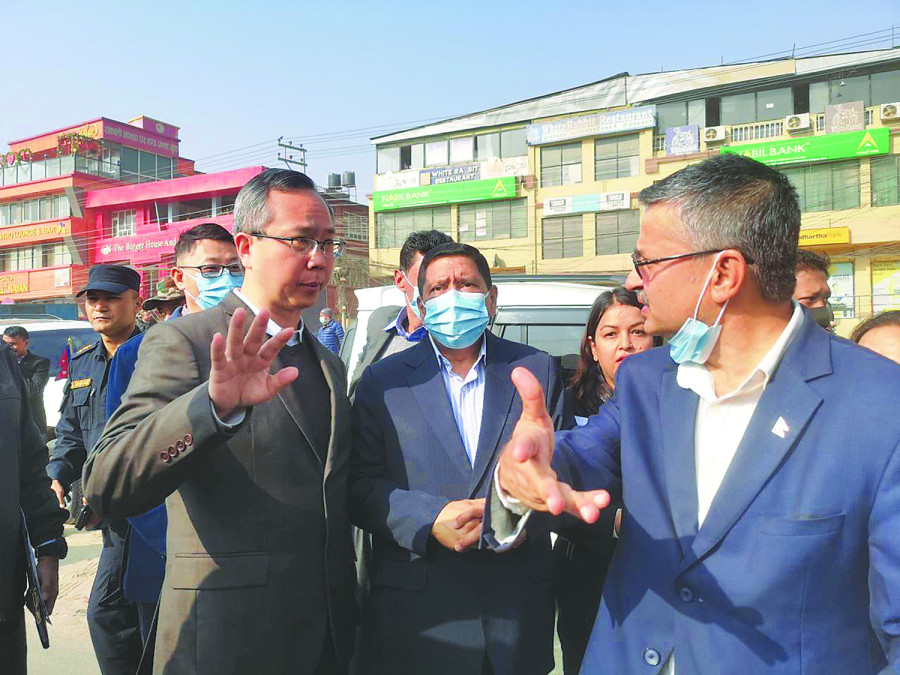Valley
Second phase of Ring Road widening project makes headway
Urban planners, activists call for prioritising pedestrians, cyclists and people with disabilities.
Anup Ojha
The second phase of the Ring Road widening project that had remained uncertain for the past three years had its hopes revived on Thursday after top officials from Nepal government and Chinese embassy along with stakeholders inspected the 8.2km project site which stretches from Kalanki to Maharajgunj.
However, urban planners and cyclists are concerned whether this project will follow the same modality as the first phase of the project that stretches from Koteshwar to Kalanki. The modality of the first section has been criticised for its faulty infrastructure as many people met with accidents and lost their lives after the Chinese government handed over the road to the Nepal government.
Deputy Prime Minister and Minister for Physical Infrastructure and Transport Narayan Kaji Shrestha, the newly-appointed Chinese Ambassador to Nepal Chen Song, Director General at Department of Roads Sushil Babu Dhakal and other officials inspected the road section on Thursday.
“It seems the Chinese authorities are now quite serious about carrying forward the project,” said Bijay Jaishi, deputy director general at the Department of Roads. According to the original plan, work on the project’s phase two was originally scheduled to start in early 2020. But it couldn’t get started as per the plan mainly due to the Covid-19 pandemic and issues related to construction site clearance.
The agencies concerned seem to have jumped into action following the inspection by the top officials.
According to Jaishi, Chinese officials had come to his office on Friday morning to ask for a conceptual cross section for the project, seeking what should be included in the new design of the project.
According to him, the Chinese officials are likely to submit a detailed project report within six months.
“During the field visit, Chinese representatives had initially pointed out that clearance is needed at three places—Swayambhu, Maharajgunj and Samakhusi,” Jaishi said. “But after we made it clear that there won’t be any problem at these places with regard to road expansion, they are now positive about carrying out the work.”
Meanwhile, urban planners and cyclists, among others, have asked the government authorities to carefully look at the design and not to repeat the problems that beset the first phase of the road expansion project, which was handed over to the Nepal government by the Chinese side in 2018.
The first phase of the 10.5km Koteshwar-Kalanki road section is blamed for several accidents due to its faulty design and lack of necessary infrastructure such as zebra crossings, traffic lights, street lamps, cycle and wheelchair lanes, and designated parkings. As such, the road section has become risky for drivers, cyclists, people with disabilities and pedestrians.
Urban Planner Suman Maher Shrestha said the second phase should not be like the Koteshwar-Kalanki section because the road was not designed keeping road safety factors in mind.
“It was later that the Nepal’s government made overhead bridges, and now a flyover is being constructed at Gwarko,” said Shrestha. “These infrastructures should have been designed earlier.”
He further said that while preparing the design for the second-phase road section, they should design it with flyovers and underpasses mainly at major bottleneck points such as Gongabu, Balaju Maharajgunj.
Shrestha, however, said that just widening roads will not solve the problem unless the government follows the mass transit concept. “While widening for the second phase, Chinese and Nepalis governments should also be focussing on a high-capacity public transport system,” he said.
“If only government authorities had carefully gone through the documents of the first phase before road widening had started, we would not have had to face this faulty infrastructure,” said Saurav Dhakal, curator of Story Cycle, a platform that works for sustainable development through storytelling and digital mapping.
In late August 2019, environmentalists, urban planners, students and other campaigners had organised a protest against the government’s decision of cutting trees along the roadside to pressure the authorities to make it environment-friendly. But that was something unheard among the concerned agencies, Dhakal added.
“Before the road clearance, we had also raised the question of why over 2,000 trees were felled and why there were no community level discussions,” Dhakal said. “There won’t be any problem if the project is late by a few months, but there should be a community level discussion over the new design and safety.” Dhakal added that the government should not neglect public concerns and safety while building public infrastructure such as roads.
Urban planners and activists have been calling for the project to prioritise pedestrians, cyclists and people with disabilities.
Last year in January, people from different walks of life, including people with disabilities, cyclists, environmentalists and artists had participated in ‘Civic Concern March’ to pressure the authorities to make the 8.2 km Kalanki-Maharajgunj section of Ring Road accessible for persons with disabilities, cyclists and pedestrians.
The Koteshwar-Kalanki stretch was rebuilt by the Chinese government. The Shanghai Construction took five years to complete the first section of the China-funded project that began in June 2013. The project was built at a cost of Rs5.13 billion.




 20.12°C Kathmandu
20.12°C Kathmandu.jpg)










